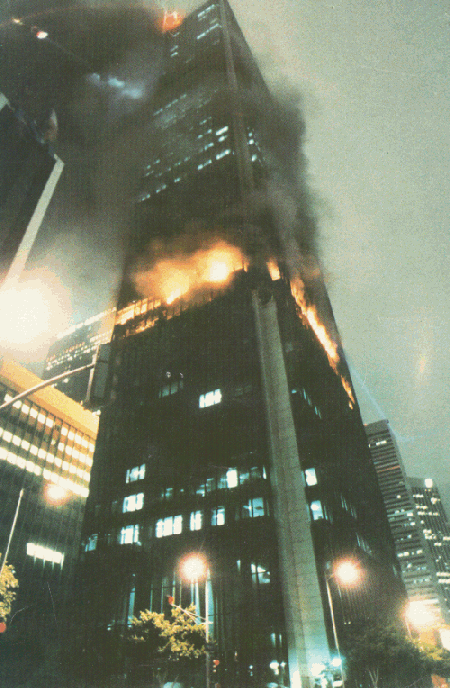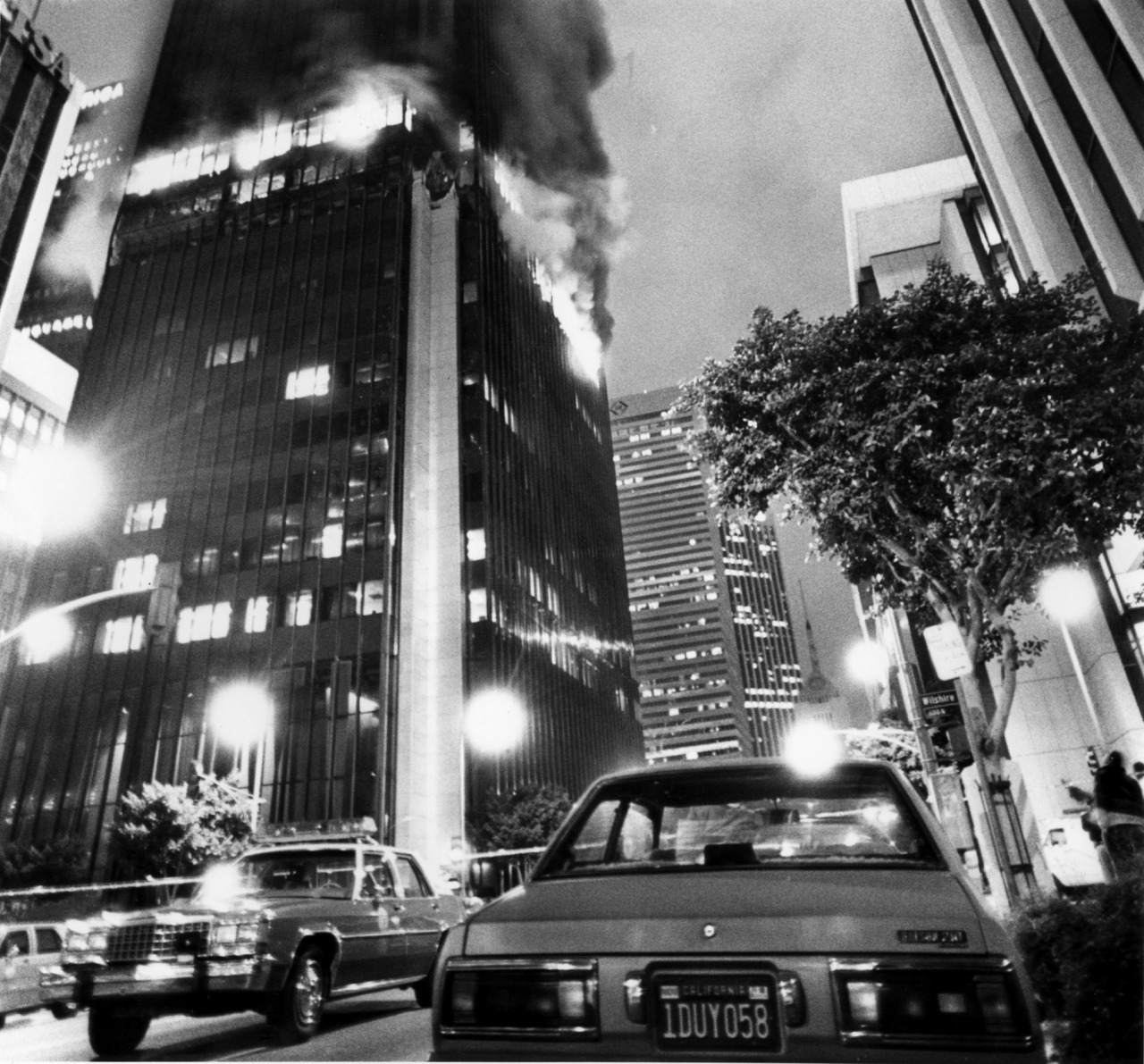Quote:
Originally Posted by tovangar2

I think the Wilshire Terrace fire has been covered on the thread, but the search function won't cough anything up. LAFD's biggest fire ever and still talked about around here. Glowing embers rained down on our house and neighborhood (I lived south of Santa Monica Blvd), leaving scorch marks but not setting anything alight (some folks living between Wilshire and Santa Monica Blvds were not so lucky). The next morning I saw hundreds of fire trucks parked diagonally on both sides of Wilshire near the disaster. A spectacular sight, glinting in the sun.
The LAT reports are here. |
You reminded me of another fire that I personally witnessed. LAFD had their hands full with this one, too.
Besides L.A. Times articles, the following links were used for information for this post. The first link has details about almost every aspect of the fire in separate page links.
http://www.iklimnet.com/hotelfires/interstatebank.html
http://blogdowntown.com/2009/09/4647...t-on-big-fires
______________________
THE FIRST INTERSTATE BANK BUILDING FIRE
On May 4, 1988, a friend and I went to see a film at the Vagabond Theatre, which showed classic and revival films at the time, on Wilshire Blvd., located just adjacent to MacArthur Park. [We went to see the film Some Came Running, with Shirley MacLaine, Frank Sinatra and Dean Martin.] Upon exiting, sometime around 11:00 p.m., we looked toward downtown and, on an otherwise clear night, we saw what looked to be smoke coming from one of the skyscrapers. Since we were so close to downtown we decided to drive down Wilshire toward this sight. If I recall, there was very little traffic that night and when we turned a corner we were shocked to see this occurring:

LAFD
This was the First Interstate Bank building, the tallest building in Los Angeles, at the time, and West of the Mississippi. It was built in 1973, opened in 1974, as the UCB, or United California Bank building and known as such until 1981, when United California Bank changed its name to First Interstate Bank. The tower was renamed 707 Wilshire Tower in 1996 and became Aon Center in 2003. It is located at the intersection of Wilshire Boulevard and Hope Street in downtown Los Angeles. (The building was built one year before it was mandatory to have sprinklers in Los Angeles' high-rise buildings.)
This building is 62 stories high.
So, what happened?
It's a tragic and unfortunate, but fascinating story.
Oddly enough, at the time of the fire, an automatic sprinkler system was being installed in the building.
This sprinkler system had been installed in 90 percent of the building, including on the fire floors. On this night, May 4, 1988, at about 10:20 p.m., the water valves controlling the systems were closed by the sprinkler contractor, to await the installation of water-flow alarms. (!)
THREE MINUTES LATER employees of the sprinkler system contractor heard glass falling and saw light smoke at the ceiling level on the 5th floor. A manual alarm was pulled but sounded for only a few seconds. It is believed that the alarm was silenced by security personnel on the ground floor. At 10:30 p.m. a smoke detector on the 12th floor was activated and was reset by security personnel. At 10:32, three additional smoke detectors on the 12th floor were activated and were again reset by security personnel. At 10:34, four smoke detectors on the 12th floor were activated and reset.
What was happening is that a fire had originated in an open-plan office area in the southeast quadrant of the 12th floor. The area of origin contained modular office furniture with numerous personal computers and terminals used by securities trading personnel. The cause is thought to be electrical in origin, but the precise source of ignition was not determined. The fire extended to the entire open area of the floor and several office enclosures to fully involve the 12th floor, except for the passenger elevator lobby, which was protected by automatic closing fire doors.
Apparently, the security people inside the building thought the shutting down of the sprinkler system had somehow caused the alarms to go off, despite the occurrences witnessed on the fifth floor. Meanwhile, witnesses outside of the building could see smoke coming from the 12th floor. At 10:36 multiple smoke detector alarms from the 12th to 30th floors activated. At this point Alexander Handy, a 24-year-old building maintenance engineer rode an elevator up to investigate what he thought was a false alarm, but a fire door was blocked when he got there. The elevator had no safety interlock or control logic to prevent him from entering the elevator and it allowed the elevator to park and open on a floor with a fire. Firefighters found his body in the freight elevator on the 12th floor. He was the evening's sole fatality. (A profile of Handy noted that he was married with a 2-year-old daughter, an Air Force veteran, and a native of the San Fernando Valley.)
Meanwhile, at 10:37 p.m., L.A.F.D. was contacted by witnesses
outside the tower, reporting a fire on the upper floors. The fire brigade arrived at 10:40 and found that the entire east side and three-fourths of the south side of the 12th floor were fully involved with fire. Unbelievably, at 10:41, the first report of the fire from those
inside the building was reported.
Within ten minutes of the fire department's arrival the fire had spread up to the 13th and 14th floors. There was heavy exposure of flames to the windows on successive floors as the fire extended upward from. The flames were estimated to be lapping 30 feet up the face of the building. The curtain walls, including windows, spandrel panels, and mullions, were almost completely destroyed by the fire. There was nothing to stop the exterior vertical spread, and fireground commanders were concerned about the possibility of the fire "lapping" higher to involve additional floors.

Boris Yaro/Los Angeles Times
At 11:10, a half hour after initially arriving, the fire department began to fight the fire.
When I arrived with my friend, around 11:30, or so, none of the side streets around the area had been blocked off and we were within a block of this building. The following photo is a good look at what I remember seeing. (In color, of course.) It was pretty staggering, and frightening and brought to mind the film The Towering Inferno. 9/11 also brought back these images to my mind.
 Flames burst from the middle floors of the First Interstate Bank building at the height of the blaze. This view is from Wilshire and Hope Streets.
Flames burst from the middle floors of the First Interstate Bank building at the height of the blaze. This view is from Wilshire and Hope Streets. Credit: Boris Yaro / Los Angeles Times
I thought I distinctly remembered seeing smoke coming from a floor way above the 16th floor, where the fire was eventually stopped. I was about to apply this idea to a faulty memory of that until I read this:
Minor fire extension also occurred via poke-through penetrations for electricity and communications, via HVAC shafts, and via heat conduction through the floor slabs. A minor fire occurred in a storeroom on the 27th floor, ignited by fire products escaping from an HVAC shaft that originated on the 12th floor. This fire self-extinguished due to oxygen deficiency, but could have greatly complicated the situation if it had continued to burn. The secondary extensions were minor compared to the perimeter fire spread at the curtain walls.
It's very surreal or strange or whatever might describe the situation when you're witnessing it in person. It's almost unbelievable. This is what I remember seeing, what I remember hearing, though, was a continual rain of glass that was falling from the side of the building. And, oddly, it was a rather beautiful sound amongst the destruction going on. On occasion, other material was falling from the building as well, though I don't know exactly what it was. The following photo was taken the morning after, and look at all the glass at the base of this building that I was hearing as it fell.
The fire started on the 12th floor at around 10:30 p.m. and by 1:30 a.m. the 15th floor was fully engulfed in fire and the 16th floor was beginning to burn. The upward extension was stopped at the 16th floor level, after completely destroying four and one-half floors of the building. At 2:19 a.m. the fire was officially declared as put out.
System failures that occurred on this evening:
--Main fire pumps had been shut down, reducing available water pressure for initial attack.
--Radio communications were overtaxed and disrupted by building's steel frame.
--Fire and water damaged telephone circuits making them unusable.
--Sound-powered emergency phone system in building was ineffective.
Other notes:
--The fire, considered to be the worst high-rise fire in Los Angeles history, destroyed four floors of the 62-story building.
--It took approximately 40% of the Los Angeles City Fire Department to put out this fire, around 300 members. (Imagine a lot of fires caused by an earthquake! You're on your own.)
--One person was killed and 40 were injured.
--Helicopters rescued people from the roof, mostly cleaning crews were in the building, while dropping off firefighters. (It's noted that since 1958, all Los Angeles high-rises have been required to have a large, flat helipad on the roof (it's the only major American city to have that kind of requirement). This is blamed for Los Angeles having a mostly bland skyline. This idea is beginning to change.)
Some eyewitness thoughts:
Jesse: "I was sitting on the steps of the L.A. City Library. Watching and eating some left over peanuts from the Dodger game my brother and I just left. It was incredible to see!"
Bob: "I know of a couple of people that worked in the building AFTER the fire. They say it's haunted with the spirit of the man who was killed when he took the elevator up and opened the door. Now they say you can see him enter the elevator with you some times and leave with you on those floors, and other times if you are working late by yourself, the keyboard will rap like someones typing next to you and the mouse in the next cubicle will move around by itself.
Tim Taylor "I replaced all the curtain wall and glass on the job. I remember we had a few ghost stories also.
A couple other stories pertaining to this building:
--As befitting a building that used to be Los Angeles' tallest, 707 Wilshire has some interesting stories. In 1976 a gunman -- who was later found to have just a starter pistol -- took chief building engineer Martin Hickey as a hostage and led him to the roof. He demanded that a written statement on the dangers of smoking be read on local radio. When it was, he surrendered to the police. The gunman, Dolphin Lair, told KFWB in a jail interview that he had tried to get the word out about smoking after his father's demise. The Times recounts: "They told me it wasn't newsworthy," he said, "So I planned this... and it was newsworthy."
--In 1982 Ron Broyles, an out of work stunt man, climbed the outside of 707 Wilshire. The Times writes that "He was trying to attract attention to himself to get work. As he climbed, a friend on the ground was available for press queries." Broyles made it all the way up the outside of the building with his clamps and rappelling gear, and then was arrested when he reached the roof.



